Every January for the last four years, I have dedicated the month to making swatches for projects or learning new techniques. Other years, I have been able to spend all my knitting time just swatching, and I have ended up with a good pile of little bits of fabric come February. This year, not quite as much, because I was in product knitter mode for a trip in the third week of January, and I had to complete a very labor-intensive popcorn-encrusted pullover for my daughter and a little dress for my granddaughter, and that cut into my nice pile of bits of fabric. Well, I did what I could.
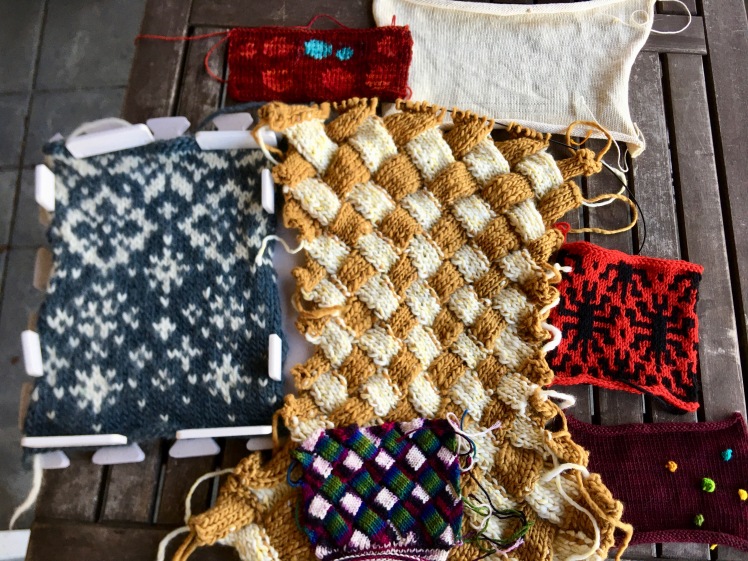
The first thing I did was my most burning source of curiosity: what would happen in double knitting if I introduced a third color worked intarsia-style? That was a burning question because I’m knitting the final phase of a jacket I’ve been teasing here for months, a double-knit shawl collar with improvised patterning of swirls and circles. So far the colors in the double-knit shawl collar have been a green gradient and a pink-orange gradient, but my plan has been to have pops of other colors when I get to the second half of the strip of double-knitting where both sides are more likely to show. So I made a swatch using a light red multi and a dark red multi to start my double knitting of improvised circles (not the easiest color combination because the two reds had colors in common, and it was hard to distinguish between them sometimes), and then I introduced the third color, a light aqua, which I attached in the center of the swatch in the place of the light red. I continued knitting the light red on either side of the aqua section with the dark red serving as contrast to both the aqua and the light red. Doing intarsia in double knitting is a whole lot like doing any kind of intarsia: you try to estimate the amount of yarn you’ll need for the section to the extent that you can control the length of the strings you have hanging, and it produces extra ends. But it’s easier to avoid holes in the fabric because the action of moving two colors forward and backward for the double-knitting automatically closes any gaps. It’s also easier to conceal the ends, because you can just work them into the fabric between the layers afterward, threading the end into a tapestry needle and pushing it between the front and back layers. This was a successful feasibility study that I will apply to my in-progress project.
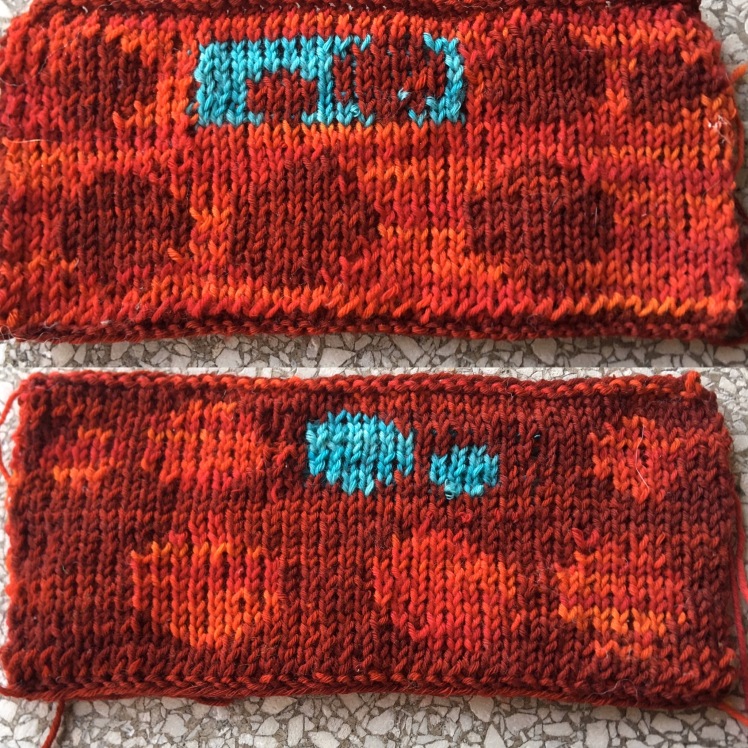
The next swatch was for my own version of my younger daughter’s latest birthday sweater, which is getting her through sub-zero Fahrenheit Minnesota temperatures thanks to the loft and thermal qualities of the yarn, West Yorkshire Spinners Re:treat Chunky Roving. My local temperatures are much milder than the dead of a Minneapolis winter, but my advancing age seems to be turning me into my mother, who wore her down jacket when it was 80ºF in her Florida apartment. I expect never to be cold again, once I have this sweater at my disposal. I’m repurposing the chart for a cowl pattern with snowflake shapes that fade the two colors of the yarn from dark to light…sadly, it may be my only encounter with snowflakes this snowless winter. The pattern was intended to be knitted in fingering weight yarn with enough stitches width-wise to make a fabric wide enough to get over a person’s head and sit around the neck, but I am knitting it in very thick yarn at a gauge that will enable me to use the chart for a sweater that will cover my entire torso. I only knitted half of the pattern in my swatch, but it was enough to show me that this was a viable plan.

When I was looking through my Barbara Walker stitch treasuries last spring in search of a mosaic stitch pattern for a linen summer top, I ran across a pattern for a scorpion. I immediately envisioned a sweater for my husband in black and an orangey-red that I bought for a sweater I never knitted, with black scorpions crawling all over a red background like an episode of delirium tremens. My husband liked the idea. So I swatched it, and the sweater is on my knitting schedule, right after I finish my “I’ll never be cold again!” sweater. It will be a fun and easy knit.

Melissa, the Lovelyarns store owner, gave me a couple of skeins of some strange and beautiful wool yarn that was painted with sparkly gold dye (Filatura di Crosa Stelle). Sparkles aren’t my usual thing, but it was pretty in the cream and golden brown skeins she gave me. The yarn reminded me of a reversible entrelac scarf pattern in a Japanese language book (Ideas for Double-Sided Knitted Scarves) that I have had for a long time and never used. I decided that this design would be a good use of the yarn and also a good way to relearn the basics of entrelac, since the design expands and contracts the size of the rectangular units, which are good things to know how to do if you want to make a yoked entrelac sweater. I had made my younger daughter such a sweater about nine years ago, but I haven’t done entrelac since then and have forgotten how to do it. Also I thought it would be fun to try to decode the Japanese instructions using context and keys to Japanese knitting symbols and English-to-Japanese knitting vocabulary lists. I also had a couple of English-language books on entrelac, which honestly weren’t a whole lot clearer linguistically than the Japanese book, but I played around with yarn on the needles and looked at the pictures and eventually got it going. This was my swatching project while I was on my trip to visit my older daughter and her family, and I got through the first series of decreases and increases for the scarf pattern. And I remembered why I had done one entrelac project nine years ago and never again: entrelac bores me.

But I was motivated to relearn the mechanics of hand-knitting entrelac rectangles that get larger and smaller because I ran across a beautiful machine-knitted entrelac yoked sweater and have become interested in learning machine-knit entrelac. There are a number of ways to do it, and each way has its application. If I had had more time during this Swatchathon, I would have worked on Diana Sullivan’s method for creating a round cushion shape, whose seamless formation of expanding rectangles is directly applicable to top-down yoked entrelac pullovers, and Roberta Rose Kelley’s method for seamless entrelac of infinite circumference, which foils the usual width limitation of knitting machines. But instead I only worked on the method taught by my machine knitting idol Susan Guagliumi in her Craftsy/Blueprint class Special Techniques for Machine Knitting: Color and Texture. This method dispensed with stitch holders and waste yarn, which Diana’s and Roberta Rose’s methods use. On the other hand, the size and shape of the rectangles cannot be increased or decreased and the width of the work is limited by the number of needles on the machine, resulting in a rectangular fabric. That’s fine for the time being, because I have something in mind for rectangular strips of entrelac. When I was making ponchos several years ago, I offered one to all of my four sisters, and the sisters in Philadelphia politely declined. But the sister in Florida left hers behind in Philadelphia after a visit, and now the two Philadelphia sisters have a daily negotiation about which of them gets to wear it, having discovered belatedly that it’s exactly perfect for dog-walking on mild winter days. So I’ll be revisiting my Poncho Envy design, but instead of a ribbed neck band, I want to do it in entrelac, folded over and sewn to the two pieces of knitted fabric that will make the poncho reversible.
Susan’s entrelac method was hard for me to get started, because weighting the stitches in the base triangle sequence was particularly persnickety, even more so than for the stitches for Lizard Ridge short-rowing, and the stitches kept falling off the needles. But once I finished the base triangles, it was fun and much more interesting to do than the handknitted version. I am also very pleased with the way the 5-stitch rectangles distribute the colors in Wollmeise multis. I used two colorways that I don’t like very much, and I was thrilled that these little rectangles squeezed every bit of beauty from them. I was also surprised at how big a 5-stitch repeat can be in machine-knit entrelac, stretching the several rows of plain knitting way out of recognition. When I make my entrelac neck bands, I’m going to have to start and end them on waste yarn and join the beginning and end together with the world’s loosest bindoff. One side of the poncho would show the bound-off edge as a visible join that would be a design feature.

Some months ago, my sister’s sister-in-law’s sister gave me a big box of balls of thin cotton twine that her late grandmother, a weaver, used to use to warp her loom. I don’t weave and never will, thanks to several courses of instruction in basic weaving that all ended up throwing out my back and incapacitating me for weeks at a time. But I do have a knitting machine! I had been warned that string used for warping could behave oddly when knitted, with unpredictable pulling on the bias and shrinkage when washed. One way to find out, right? I cast on 100 stitches on the machine and knitted 100 rows. I discovered there were small knots in the string, and a few discolorations here and there, and the ball needs to be rewound into a cake to make the string more digestible for the machine, but the resulting fabric retains its rectangular shape and doesn’t shrink. It has an attractive natural look that would be effective in garments that make a virtue of deconstruction. In fact, I saw a pullover the other day made of cotton in a natural cream with an arrangement of holes and eyelets that had a little element of randomness… so me! So this swatch will beget further swatching in order to experiment with holes and laddering techniques that Susan Guagliumi explains in her book Open Spaces. I might also start playing with dyeing garments made from this fiber, maybe painting them?

My final swatch in this year’s Swatchathon is a further exploration of Susan Guagliumi’s methods for creating 3- and 5-stitch popcorns. I had tried out her method for 3-stitch popcorns using “borrowed” needles when I made the pocket for a child’s dress, and I wanted to consolidate my understanding of the method, as well as learning how to make 5-stitch popcorns. This 5-stitch method has you taking four stitches off the needles and onto a circular knitting needle while the popcorn is being formed onto the four empty needles and the needle right next to it. It doesn’t matter if that needle is to the right or left, but for some reason I’ve been using the needle to the right. Since my popcorns are different colors than my main yarn, I’ve been hand-manipulating the yarn for the popcorn onto the needles for five rows, then transferring the right-most and left-most stitches to the bobble stitches next to them, knitting two more rows with those three stitches, then repeating that operation to leave a single stitch in the middle and hand-manipulating the yarn through that one stitch. Then I transfer the stitch to the right-most needle and lift a first-row stitch from the right and left of the bobble onto the stitch on the needle and replace the four stitches onto their original needles.
I suppose it’s not too surprising that I had a plan for this swatch. In addition to learning how to make these popcorns, I also wanted to try out the colors and to check the spacing of the small popcorns surrounding the big popcorn, which in my own mind suggest planets revolving around a sun, even though they probably don’t look that to anyone else. I think I’m going to add another couple of small popcorns later, which I think I can do by hooking a stitch of the fabric onto a needle and hand-manipulating a 3-stitch popcorn in the same way as I made the original ones, then poking it through to the right side and affixing it more firmly to the fabric with the ends. Eventually this swatch will be trimmed with fuchsia i-cord and attached to a sweater as a pocket. That garment will be the final sweater in my series of sweaters with set-in sleeves, popcorns, i-cord trim, and decorative side seams. It’s going to be a long and detailed blog post, I expect.

I’m regretful about the things I didn’t get to in this year’s Swatchathon, which were experimenting with making “plarn” out of the millions of plastic supermarket bags I’ve been storing and figuring out how to crochet a polka-dotted market bag out of them; exploring the tuck stitch patterns on my knitting machine; and swatching the hand-knitted analog as described in a book I’ve had for a couple of years and hardly even opened, Dimensional Tuck Knitting by Tracy Purtscher. And of course there are the experiments I mentioned above in order to learn how to machine-knit a yoked entrelac pullover (a brilliant way to use my one-off skeins of Wollmeise multis, especially the ones I don’t like that much) and ways to make laddered and hole-filled stitches in garments made of that cotton warping yarn. Maybe there will be a January 2020 Swatchathon in April?
Now for the annual feature of my January Swatchathon posts, the Where Are They Now segment, in which I report the eventual disposition of the previous year’s swatching. Here’s the class of 2019.

Clockwise from top left corner:
German swing knitting swatch. I don’t like garter stitch enough to do swing knitting again, but I’m dismantling the technique for parts. German short rows have become my go-to for shaping shoulder slopes in hand-knitting, and I have used it over and over again in the last year. I also have been experimenting with the visual effects of short rows in machine knitting, and I have thoughts about even more experiments with it.

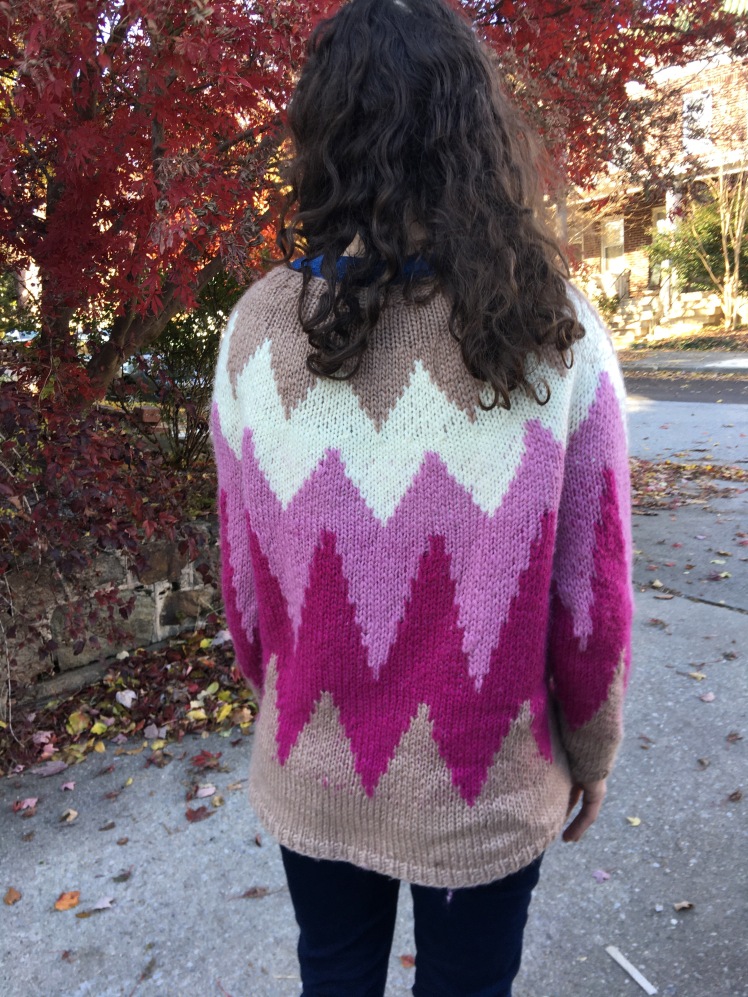
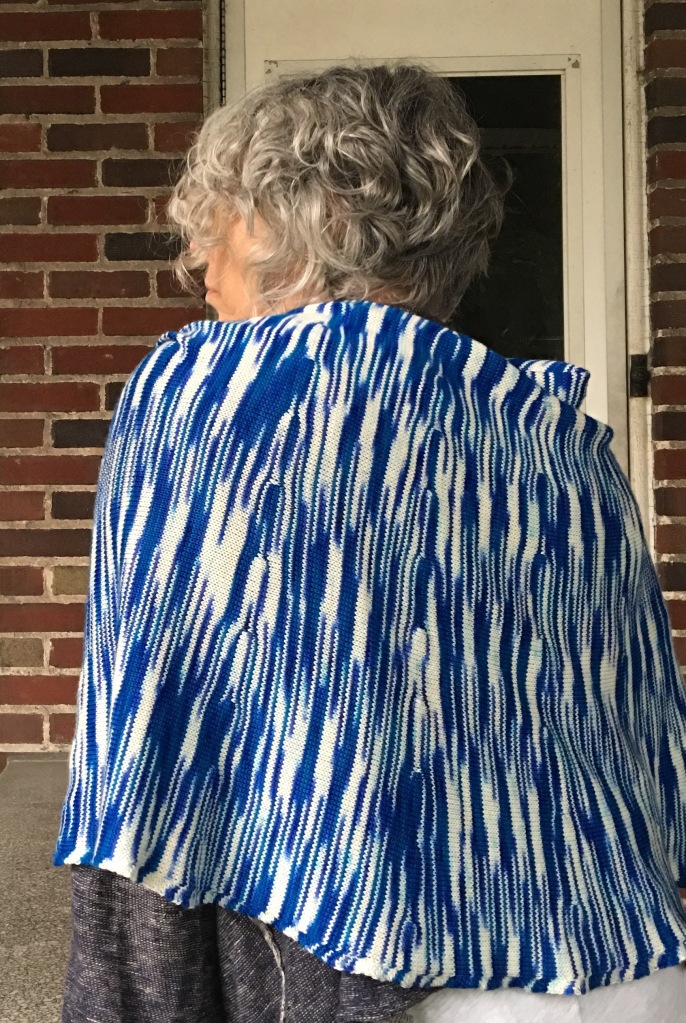

Replication of authentic Bohus hat. Nope. Never again. I’m not pouring my time, OCD tendencies, skill, and resources into an expensive kit to make someone else’s usually frumpy design just to achieve the Bohus purism police’s notion of authenticity. I don’t wanna and you can’t make me.
Machine-knit hats. I really liked using my plant-dyed yarn in 4-row stripes in machine knitting. I made my husband a sweater with plant-dyed yarn in 4-row stripes, and it’s one of my favorite pieces of work in 2019, and maybe ever.

Shadow knitting. Interesting effect, boring to knit. I have no desire to do it again.
Improvised double knitting. Yes! I love it! It takes 10 forevers to do it, but I love every stitch of it. And right now I’m doing a lot of stitches of it, in that 8-inch-wide shawl collar I mentioned above.
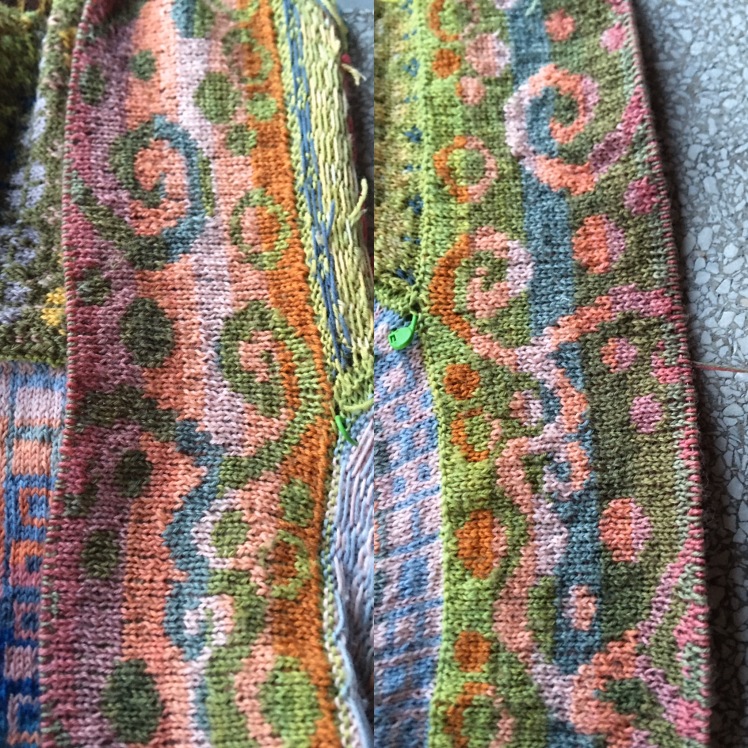
Stranded lotus. It turned into a nice sweater. And I used German short rows for the shoulder shaping.

Machine-knit fairisle. I didn’t do as much with that in 2019 as I had expected, but I used that swirl pattern in a couple of hats, and I used a preprogrammed fairisle pattern for the pockets of my jacket and another in a sweater for my grandson. Maybe 2020 will be a big year for using the electronics of my knitting machine. And if not 2020, hopefully there will be other years when I do.

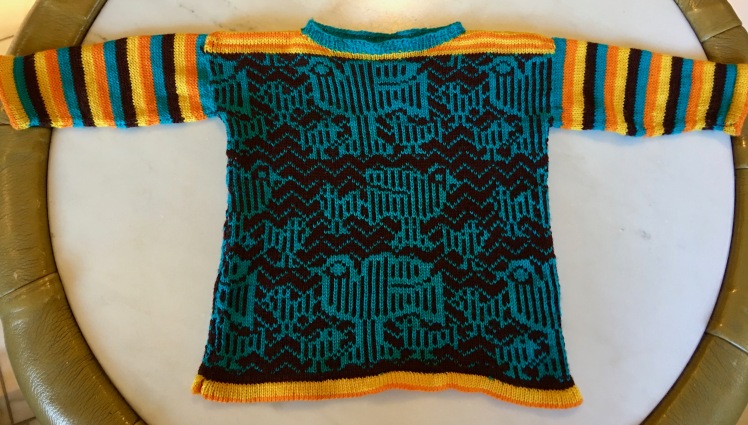

About the cotton twine knit – I love painting fabric and think that painting your knitted cotton twine would be a great experiment. My favorite paint for this purpose is Jacquard textile color for natural and synthetic fabrics. I buy the paint from Dharma Trading.
LikeLike
I have gotten a recommendation for a type of dye from Dharma whose name I can’t quite remember. Something like Scion? Although I think that’s a car….
LikeLiked by 1 person
Btw, I really like your 2019 harvest, especially the stranded lotus sweater and the short-row shawl.
LikeLike
Thanks! I really ought to give the shawl more play, especially since my sister made me a pretty broach that holds it firmly in place.
LikeLiked by 1 person
I love how you are constantly challenging yourself. The way you use the short row technique is very subtle. Lovely.
I think the way the two multis in intarsia look stunning!
LikeLike
Thanks so much! January Swatchathon really powers my work all year long and for years afterward.
LikeLiked by 1 person